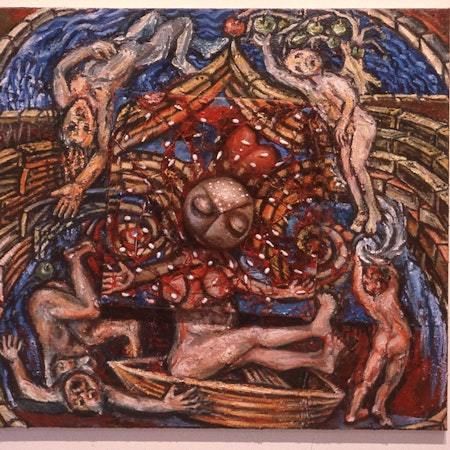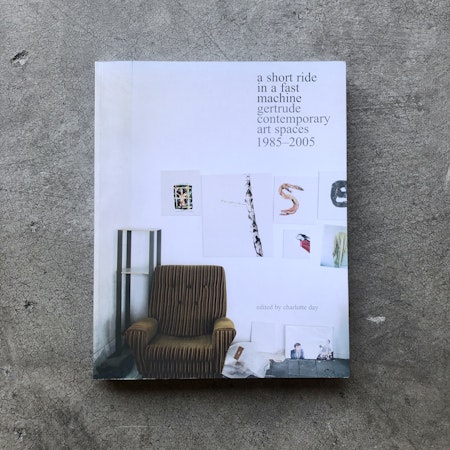“I wanted the paintings to be overloaded and crammed extravagantly like icons – small but intense works to be viewed individually as parts to a whole. I have usually explored my thoughts in miniatures and small details to allow the viewer an intimate relationship with the work. I had the idea that many dimensions of time and space, both literal and non-literal, could be superimposed visually upon one another and placed side by side at the same time. I wanted different aspects to intersect and repel, to harmonise and conflict with one another in the same picture. One’s perception then would not be limited by ‘truth’ or ‘lies’ because all things would have their own form relevant to their own specially invented environments and relationships. As an extension of these ideas, a number of the works are constructed with three-dimensional objects and materials, many of which are painted illusionistically into the picture plain. The result is a kind of sculpted painting – a paradox of illusions. Most of the pictures are kaleidoscopic, but amidst the intentional cacophony are isolated moments of reflectiveness and distillation.” (Merrin Eirth 1986).
The pictures are full of play. Intentional ambiguities and double entendres tease yet affirm one’s perception of the world. Awkwardness, as a condition of human frailty, is the essence of the tragi-comic situations presented.
Traditional biblical characters and anecdotes dominate the work, appearing simultaneously with personal visualisations of events and experiences, sometimes sympathetic, sometimes jesting and at other times with challenging disparity. As in Greek tragedy, there is a limited number of stock characters, most of which are played by a Pierrot-angel, who is the protagonist as well. This chameleon-like persona explores more than one aspect of an idea at once.
The animal images are products of the protagonist’s imagination. They allude to specific emotional situations rather than represent general concepts, notwithstanding their traditional symbolism which provides an additional perspective in accordance with longheld and popular beliefs and superstitions.
The boat has long symbolised the journey of transition from one world to another. This symbol is used repeatedly in the work. In many of the pictures it represents a state of flux, the image insistently recurring in many different circumstances. The Second Fleet (cat. No.2) depicts a group of figures in sunglasses sailing in individual boats, away from the auras of two hearts, one radiant, one unfolding, towards one outside the picture frame. Although it appears to be painted on the same plane, their destination is physically alienated from the picture in which they exist, their folly or doom sealed. The impression is that a ‘trade-off’ is afoot, of true personal goals for sensational heresay.
Human Face 1 and Human Face 2 (cat. No.3 and 4) explore a similar subject, more specifically the psychic physiognomy of the protagonist. These two pictures share a common central motif – the sole of a shoe. The first is analogous with the destruction of the perfect mystery of Faith. A Christ-like portrait appears on the heel of the shoe; a mass of metal shavings, the remnants of exposed and defunct inner works, are placed on the remaining sole. This sole forms the nose of a larger face. Screws protrude from the eyes and course down the face in a choreographed stream of tears. The mouth smiles weakly, a marble balanced on the chute-like tongue.
The second painting is a bilious ‘sole-face’. Pins prick its edge with a bristling effect. The sickly ulcerous face forms a cess-pool below which a lung-like heart, dark-veined with artificially bright capillaries supplies carcenogenic life-blood to the body. The mystical Third
Eye is a fragment of mirror; the viewer is reflected in miniature, implicated through the innocent act of looking. The jealous martyr has become the purveyor to his own plight, his countenance shaped by self-inflicted anguish.
Catch Me if You Can (cat. No.12) is one of the splintered paintings, comprised mainly of shards of glass. It plays with the notions of goodness and indulgence. A woman trots alongside a pig, obliviously becoming one and the same with it. An indulgent man stretches out to grasp a white lamb. Glass and carpet form the inconsistent surface of the painting, giving an impression of fragility and vulnerability amidst altered securities.
The apple is a constant but Chimera-like image, appearing and reappearing metaphorically as the Fruit of Knowledge, as Temptation, as Consciousness and as Jealousy (see Fat Spirit O.K., cat. No.6). Alternatively, in Crucufixion (cat. No.23), in which a female figure is tempted by martyrdom itself, a golden apple is balanced on Christ’s head. This implicates him as a target for the often conflicting notions of one’s responsibility as a rational being and as an intuitive creative being. The ensuing dilemma of effecting a balance of the two is as prominent here as in many of the other works.
Such propositions are neither solutions nor indictments. They do, however, present a paradoxical view of naive faith and curiosity. Much as the paintings allude to the mysterious side of life, they also humanise the difficulties and triumphs inherent in emotional dealings and perceived realities.

